Posts Tagged ‘tigerquoll’
Saturday, May 11th, 2013
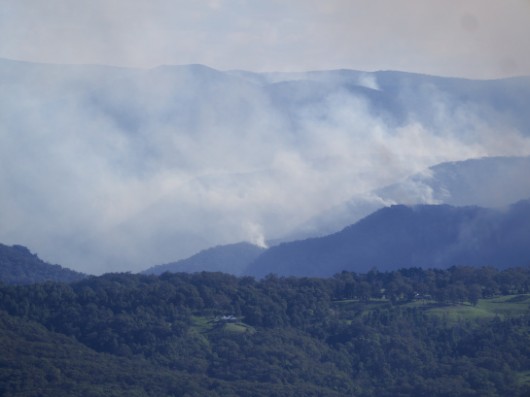 Aerial Arson of Mt Cronje
(A recent example of aerial arson to the Blue Mountains World Heritage) Aerial Arson of Mt Cronje
(A recent example of aerial arson to the Blue Mountains World Heritage)
.
Once again across the Greater Blue Mountains World Heritage Area, smoke blocks out the horizon.
Once again the custodian of the natural values of the World Heritage Area has set fire to it in the middle of wilderness, over 15km from the nearest human habitation.
The New South Wales National Parks and Wildlife Service (NPWS) Regional Manager, a Mr Geoff Luscombe, is proud of his widespread lighting of natural vegetation in as part of the cult of ‘Hazard Reduction‘.
On this occasion some 5,640 heactares of wilderness vegetation in the remote Wild Dog Mountains of the southern Blue Mountains National Park was targeted as a hazard.
This wild wilderness region is wholly within the internationally protected Greater Blue Mountains World Heritage Area. And so we have wolves managing the chickens.
It was a hazard because it hadn’t been burnt for many years, perhaps 20 years, so according to hazard cult orthodoxy, unburnt bushland asked for it and so had to be burnt. No concern for native fauna was made and no concern for fire sensitive flora was made. Such values are condemned as fuel hazards.
.
 The Tigerquoll (Dasyurus maculatus)
A rare and threatened top order predator of the Blue Mountains
The Tigerquoll (Dasyurus maculatus)
A rare and threatened top order predator of the Blue Mountains
.
Like in the Vietnam War, the choppers were called in with aerial incendary to set fire indiscriminately to all wilderness below and to its world heritage values.
.
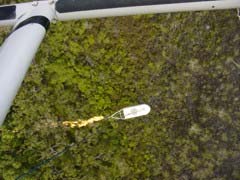 Aerial incendiary dropped from helicopter in National Park wilderness Aerial incendiary dropped from helicopter in National Park wilderness
.
So the NPWS set fire to the vast wilderness area way south of Jamison Valley, way south of Mount Solitary and south of Cedar Valley beyond – between Green Gully, Cox’s River, Narrow Neck and the remote Wild Dog Mountains.
Hazard reduction for whose perverted gratification, and to benefit whom?
And Luscombe boasted that the Wild Dog West burn will be the largest burn undertaken in Blue Mountains National Park for many years.
Once underway, the Wild Dog Mountains burn will affect the following locations:
- Green Gully picnic and camping areas (Dunphy’s Camp) will be closed during and after the operation
- Wild Dog Mountains, the Kanangra to Katoomba track, Splendor Rock, Yellow Dog track, Blue Dog track, Breakfast Creek track, Carlons Head off Narrow Neck Bell Bird Ridge track and the Cox’s River south of Breakfast Creek
.
Since 1st July 2012 the NPWS has completed more than 210 burns totalling more than 110,000 hectares – our largest ever Hazard Reduction Programme. This is more than 65% of all hazard reduction carried out in NSW during the period, despite NPWS managing just 25% of the state’s fire prone land.
This hazard reduction burn is part of the NSW Government’s $62.5 million package to boost bushfire preparedness and double hazard reduction in the state’s national parks over where conditions allow.
.
[Source: ‘Hazard Reduction Burn proposed for Wild Dog Mountains’, 20130501, New South Wales National Parks Service, ^http://www.environment.nsw.gov.au/media/OEHMedia13050102.htm]
.
 $62.5 million is going to setting fire to Blue Mountains World Heritage
How much or little goes to protecting endangered wildlife and their Recovery Plans?
Zilch across the Blue Mountains? $62.5 million is going to setting fire to Blue Mountains World Heritage
How much or little goes to protecting endangered wildlife and their Recovery Plans?
Zilch across the Blue Mountains?
.
Perhaps this National Parks Report from 2007 in the Blue Mountains, which is probably sitting on some dusty NPWS shelf, may ring a bell for our Mr Luscombe.
Do the recognised practices of “mosaic burning” and “retaining fauna habitats in a long unburnt state” have any meaning in National Parks management?
.
.
Tags: Blue Mountains, Fauna of the Blue Mountains Special Areas, Geoff Luscombe, Greater Blue Mountains World Heritage Area, hazard cult orthodoxy, hazard reduction, Hazard Reduction Programme, Helicopter Aerial Incendiary, NPWS, playing with matches, tigerquoll, Wild Dog Mountains
Posted in Blue Mountains (AU), Threats from Bushfire | No Comments »
Add this post to Del.icio.us - Digg
Monday, February 20th, 2012
 “Let us bind ourselves tightly to the Sorrowful Heart of our Heavenly Mother and reflect on it’s boundless grief and how precious is our soul.” “Let us bind ourselves tightly to the Sorrowful Heart of our Heavenly Mother and reflect on it’s boundless grief and how precious is our soul.”
~ Saint Padre Pio
.
Kangaroo meat involves live castration. Would you like red wine, pear juice and cranberry jelly with that?
The following video confirms Australia’s rural culture encouraging a psycho-sadistical and brutal hate towards wildlife.
It could be of elephants or rhinos in Africa, it could be Nazi Germany or Poland, or Rwanda or Serbia, but it is rural Australia and its precious wildlife. It is 19th Century depraved sadism and kangaroo slaughter is condoned by Julia Gillard’s Australian Government. This is how rural Australian shooters treat wildlife, like Japanese fishermen treat dolphins at Taiji.
It is akin to the teenage deviantism of Tasmanian mass murderer Martin Bryant and straight out of the film Wolf Creek .
.
WARNING: This video is extremely disturbing and not suitable for children. But it needs to be made public! In 2012 it reflects the callous reality of rural Australia. No wonder urban Australia turns its back on rural Australians and starves them of funding – such sadists only deserve an eye for an eye.
Click to view video:
.
Honesty, I could not inflict such callousness on any sentient being.
But if I was sure of the culpability of such a monster, wildlife thereafter would have no fear.
.
Tigerquoll
Suggan Buggan
Snowy River Region
Victoria 3885
Australia
Tags: holy mary, kangaroo meat, kangaroo slaughter, kangaroo slaughter for fur, kangaroos, Martin Bryant, rural Australia, Taiji, tigerquoll, wildlife slaughter, Wolf Creek
Posted in Kangaroos and Macropods, Threats from Poaching and Poisoning | No Comments »
Add this post to Del.icio.us - Digg
Tuesday, November 29th, 2011
This article was initially published by Tigerquoll 20090621 on CanDoBetter.net in the aftermath of the devastating Victorian bushfires that climaxed on 7th February 2009:
.
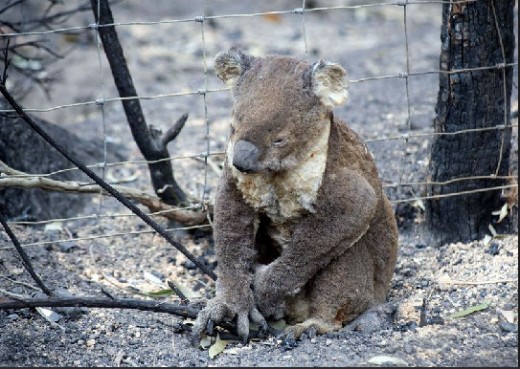 A forgotten victim of bushfire
A forgotten victim of bushfire
.
The analogy of the Titanic ocean liner disaster of 15th April 1912 is apt in relation to rural communities entrusting those in charge to be able to deal with public/national emergencies. The public trusted the Titanic met government standards. But 2,223 people boarded and 1514 died from the iceberg collision. Government standards were later revealed as substandard.

Public trust in government is appropriate (it’s why we pay our bloody taxes), but government systemically neglects its responsibility and abuses that public trust. Government has the nerve to entice volunteer members of the community to do its dirty work – aka the CFA. So individuals have given up on their government to be able to respond adequately to emergencies (bushfires, floods, droughts, etc) feel compelled to take measures themselves. Building a bunker is a vigilante response. I’m not saying its not a constructive response, but it is a consequential reaction of government failing to protect bushfire-prone communities. It’s like residents losing faith in the police and feeling compelled to being vigilantes. It’s akin to Titanic passengers bringing along their own liferafts.
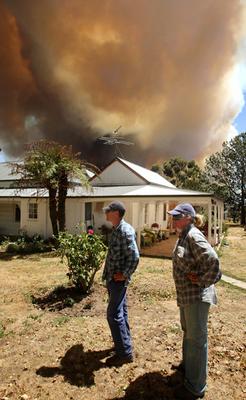 ‘Stay or Go‘? ‘Stay or Go‘?
.
To attribute blame on climate change ignores the role of government and in the case of the 2009 Victorian Bushfires lets government get away with manslaughter – literally.
Look into the history of the causes of the Titanic sinking and one can draw many comparisons with the failures of Emergency Management Australia in how it failed to protect life, property and ecological values from the bushfires across Victoria last January and February. The root causes of the (a) 1914 Titanic’s sinking and (b) the loss of 1514 lives were: management culture, poor contingency planning, design flaws, poor governance (e.g. inadequate safety regulations), poor operational response, amongst others.
 Victorian CFA Chief during Victoria’s tragic 2009 bushfires Victorian CFA Chief during Victoria’s tragic 2009 bushfires
The root causes of (a) the 2009 Victorian Bushfires being allowed to grow into unstoppable infernos and (b) the tragic loss of 127 lives were: management culture, poor contingency planning, design flaws, poor governance (e.g. inadequate safety regulations), poor operational response, amongst others.
The basic question is what emergency strategy was adopted to deal with the Victorian bushfires and why didn’t it work adequately to achieve a best practice outcome – no lives lost, no houses lost, no wildlife killed?
 Words from Strathewen
. Words from Strathewen
.
A root cause of the firestorms being allowed to become firestorms from multiple ignitions is that insufficient dedicated resourcing was provided to deal with the hundreds of ignitions in extreme tinder dry conditions with high winds. The government agencies (CFA, et al) knew the fire index was 300, that this was the worst on record, yet did stuff all to prepare or warn the public. There was a wind change forecast, yet this was not communicated to residents. Relying upon volunteers to drive fire tankers to remote ignitions is proven as ineffective as pissing into a wall of flame.
The 1940’s fire fighting thinking needs to be overhauled – by the time the 000 call is received, the volunteers are called in, drive their fire trucks out to an ignition, two hours later, that ignition has spotted into a fire front and its too late! Happens all the time!
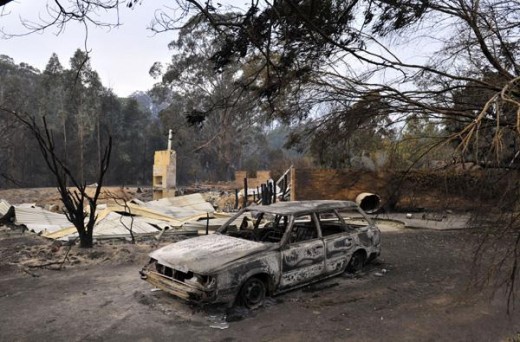
Trapped and no hope
.
Another root cause is government allowing people to build in the bush in extreme fire risk locations and in houses that are not bushfire resistant. The tragedy is that after the Royal Commission, the likely response is to incinerate the bush like no tomorrow – destroy the natural environment that people yearn to be near. It will fail to recognise the complexity of the causes and the solutions and will advocate a knee-jerk – troglodyte (‘ugg ugg’) burn the lot approach. The Commission’s verdict will fuel Brumby’s Final Solution to prescribe Victoria back to the Stone Age.
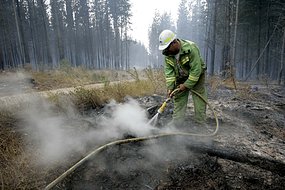
A key question is what is government leadership in fire fighting to do – i.e Emergency Management Australia? How about four fundamental approaches:
- Introduce world-leading scientific research and monitoring of bushfire threats – climate and weather conditions, bush conditions, arson investigation, lightning, and integrate these with bushfire fighting.
- Obtain state-of-the-art monitoring of bushfire-prone areas across South Eastern Australia to the point where ignitions and plumes in the remotest of locations can be detected within minutes of them starting, feeding this data to a central database and to a standby emergency professional and national response unit.
- Employ military-esque emergency services professionals to respond to ignitions within an hour of starting – airborne professionals, not a volunteer ‘dads army’ sitting in trucks.
- Resource Australian Firefighting with serious air resources to combat bushfires with military efficiency and scale. A chunk of Rudd’s $26 billion budget on Defence should have gone to setting up a national airborne fire fighting response division and an integrated satellite detection, alert and response system/unit. Isn’t this defence at home?
.
Unless the above is done, nothing will change, but now that Titanic has sunk (Victorian Bushfires killed 173 human lives, cost billions in property losses and contributed to many local wildlife extinctions) we no longer should be shocked when it happens all over again.
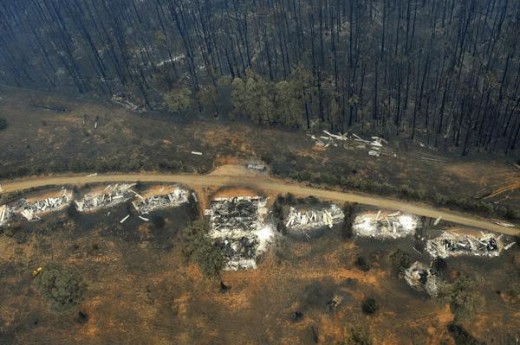 Kinglake aftermath – homes and lives incinerated Kinglake aftermath – homes and lives incinerated
.
As for bunkers, no government will guarantee a bunker to protect life ever.
One must attribute responsibility to the top of government, down. I hold Kevin Rudd accountable for the next bushfire tragedy and we are six months before next January.
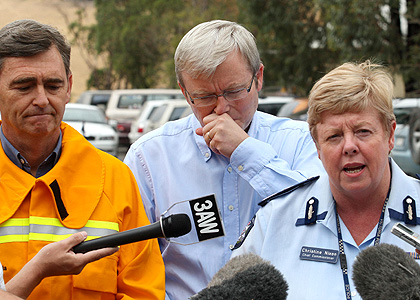 Brumby, Rudd, Nixon- the ultimate emergency leadership responsible for the Victorian Bushfires outcome of 2009 Brumby, Rudd, Nixon- the ultimate emergency leadership responsible for the Victorian Bushfires outcome of 2009
Ultimate government leadership has ultimate responsibility for public emergency
– the resourcing, the planning, the risk recognition, the mitigation, the response, the compensation.
.
In bushfire management, political will continues to be negligent.
.
.
Tags: bush fires, CFA, Emergency Management Australia, emergency services, Kevin Rudd, Kinglake, Premier Brumby, Stay or Go, Strathewen, tigerquoll, Titanic, Victorian Bushfires 2009, wildlife victims of bushfire
Posted in Threats from Bushfire | No Comments »
Add this post to Del.icio.us - Digg
Thursday, September 15th, 2011
The following article was published on CanDoBetter.net today (20110915) by wildlife ecologist and biologist, Hans Brunner, under the title: ‘A planned slaughter of endangered wildlife’
.

The Victorian Government plans to drop 1080 poison bait from an aircraft into forests could result in the extinction of the already critically endangered Spotted-tailed Quoll.
The purpose of this antiquated and vandalistic method is to poison wild dogs. Why is the Victorian Government using old, dangerous methods? This is like re-introducing the use of DDT. It is now a double disaster; all Ted Baillieu has to do now is to aerial bait to kill wild dogs in order to protect the cattle he allowed to go back into the mountains! Spot-tailed quolls and other dasyurids are meat eaters as well as some species of possums, reptiles, bandicoots and birds. They would be all at a serious risk of being poisoned. Further more, most of this bait would be wasted because of the dogs not being able to find them and this is where non-target animals will rather find and eat them. Baits have therefore to be placed only in places which dogs frequently use, along forest tracks.
.
More effective methods
There is a well researched and efficient method for the poisoning of wild dogs and foxes. It is a target specific bait station system which is successfully used throughout Victoria. Bait stations are placed along forest tracks where activities of dogs are observed.
A bait station consists of a mound of soil about 20 cm high and one meter in diameter. An un poisoned bait (free feed) is buried in the center of the mound about 10cm deep with some SFE lure placed on top. When the bait has been dug up and eaten, a check is made, with some experience, to assess whether a dog or fox took the bait. If satisfied that a target species took the bait it can be replaced with a poison bait. If it appears that a quoll or an other non-target animal may have taken the free feed bait, continue free feeding that station to keep the quoll and others away from a poison station (about 2 km away) or eliminate that station.
.
This is the only responsible way to poison dogs and foxes. Even better, it will be of great benefit to not only the quolls by removing the competition by dogs and foxes of their natural prey species, but also for the survival of Kangaroos, wallabies, bandicoots, possums, echidnas etc.
.
Biologist’s experience of alternatives
I have researched and tested this system in 700 square km of forest between Gembrook and Neerim and found it most effective and efficient. I have also introduced it in NSW National Parks where it was recognized as “The dog baiting stations proposed by Hans are the best practical suggestion to date. With the implementation of the bait stations, properly maintained and serviced at the appropriate times, there would appear to be NO reason to allow the continued use of aerial baiting” and, “Poisoning using the buried bait technique is still proving extremely target specific, with dogs and foxes being the only species killed”.
.
Do it the right way and wildlife return
Barbara Triggs, an eminent naturalist stated after poisoning wild dogs and foxes and using the bait station system on her property in Croajingolong National Park, East Gippsland:
.
“At no time has there been any evidence that a bait has been taken by a non-target animal. In the past year the numbers of native animals seen on the property have increased startlingly. The Red-necked Wallabies, who’s group was here in low numbers, have increased markedly from five individuals to now at least fourteen. The most surprising increase has been in the population of Long-nosed Bandicoots. The Dusky Antechinus, Swamp Rats, Water Rats, Sugar Gliders and several species of ground-nesting birds and also species of owls are much more in evidence than ever before.”
.
With all this evidence, this non specific and irresponsible aerial baiting must be immediately stopped.’
Hans Brunner
Wildlife biologist
Sept 2011
Saturday, August 27th, 2011
The following ultra-short article was initially published by Tigerquoll on CanDoBetter.net 20090507 under the title: ‘Premier John Brumby – a man of principle, a ‘year of action’ logging Old Growth at Bungewarr Creek‘
.
Senseless slaughter of Victoria’s Old Growth..another Brumby legacy for Victoria
29 April, 2009:
The result of senseless logging at iconic Bungewarr Creek, far East Gippsland. Loggers have desperately chainsawed magnificent stands of ancient Australian Eucalypts along Bungewarr Creek in East Gippsland as the woodchips, allowing our natural heritage to be sold out to the Japanese for a despicable $2.50 per tonne!
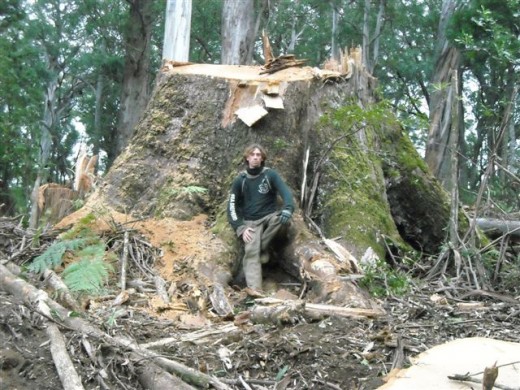
“Two protesters are ‘flying’ a platform located thirty metres up in the tree canopy”.. “this platform is cabled off to four logging machines, immobilizing them.”
First blockaded in 1994, Old Growth at Bungewarr Creek has been targeted by loggers ever since. Premier John Brumby simply cannot be trusted with Victoria’s natural heritage.
.
.
Subsequent Comments:
.
‘Sell the loggers not the logs’
On May 7th, 2009 Sheila Newman replied:
Maybe these stooges for big companies would get more money selling the loggers?
Sheila Newman, population sociologist
.
.
‘Rampant materialism and environmental destruction!’
On May 7th, 2009 Vivienne replied:
About 90% of what comes out of our old-growth forests ends up as woodchips to make paper, the majority of which is sent overseas. The “management plan” for Tasmania’s Upper Florentine Valley means a growing logging industry for wood chips, with a current price a mere $2.50 per tonne!
Despite the area being surrounded by mountains of the Tasmanian World Heritage Area, the Colonial ignorance of slash and conquer the bush has changed little since the last Tasmanian Tiger was captured there in the 1933.
All this so-called “sustainable forest management” is just thinly disguised eco-destruction by Tasmania’s logging industry.
We are bombarded with ecologically “friendly”, “sustainable” and “green” language, but the euphemisms are totally contrary to everything they claim!
We are encouraged to avoid plastic bags, turn off power when it is not needed, use energy-friendly light bulbs, save water, use public transport, but the benefits of these actions belie the fact that our governments continue to support the large polluters and industries that are adding to climate change and conservation threats!
Our leaders must be held accountable the rampant materialism and environmental destruction that our nation is succumbing to.
.
.
‘Logging contracter attacks Bungewarr protesters’
On May 9th, 2009 jim barton replied:
i have lost several thousand dollars in income due to the pathetic protests the greens have undertaken over the last 2 weeks in the bungewarr area. If you have a problem take it up with the state government directly or the vic forests office. No one will ever take you seriously while you are illegally chained to a machine or strung up a tree stopping the people who are there to make money to feed our familys. Do you honestly think the state government gives a shit while you are taking this sort of illegal action? The only people losing out are the loggers by taking away a slab of our income, the easily led pawns the greens send in to the protests that come out feeling like heroes but now have a criminal record for life. Also not to mention the tens of thousands of tax payer dollars that get spent on the police rescue squad coming from melbourne just to release the protesters and also the local police time wasted. Start using your brains and be a little more democratic and also start telling people the truth about our logging practices instead of just the lies you make up to sway the public to your way of thinking. Old growth forest dosn’t absorb carbon dioxide like you say so if you want to get technical we can say that we are helping climate change by replacing it with smaller re growth that with filter the atmosphere a lot more efficiently. This is a saw log driven industry, the pulp that goes for wood chips is what is left over from the tree after the saw log has been taken. Stop the lies and the pathetic protests because no one listens when you go about it in this way. Your protests are just an excuse for camping up the bush smoking dope, dancing around a fire by night, then during the day trying to fighting for a cause that not that many of them really know that much about.
.
.
‘State Government does not listen to decent protests!’
On May 9th, 2009 Jose replied:
Extreme protests are because our State Government is only interested in money and the votes of businesses, and jobs for forest workers. Extreme protests gets the public and the media’s attention. The income of loggers is a minor and short-term affair. These old-growth forests and trees have been here since Columbus discovered America, or before! They have TIME and GREATNESS on their side, and these stalwarts stand as sentinels against the wreckage that humans in power want to inflict on them, for a paltry $2.50 per tonne! They store massive amounts of carbon, and chopping them down is environmental vandalism. Get a job, Jim Barton! Nobody accepts the green-washing bulls**t our State government comes out with! They are all lies.
.
.
‘VicForests no different to Indonesian Timber Mafia’
On May 11th, 2009 Tigerquoll replied:
Illegal logging involves “wood harvesting, processing and trade that do not conform to law. Illegalities occur right through the chain from source to consumer, the harvesting procedure itself may be illegal, including corrupt means to gain access to forests, extraction without permission or from a protected area, cutting of protected species or extraction of timber in excess of agreed limits. Illegalities may also occur during transport, including illegal processing and export as well as mis-declaration to customs, before the timber enters the legal market.”
Other examples of illegal logging are:
* Under-reporting harvest volumes and tax payable
* Ignoring selective cutting guidelines
* Harvesting outside concession boundaries
* Falsifying log transport documents
* Accepting falsified log transport documents
Timber can also be considered illegal if the plantations are not properly managed.
This includes:
* Clear-cutting natural forest, then failing to replant
* Not planting at rates required to maintain long-term production
* Replanting with low-quality species
* Replanting at low density.”
SOURCE: http://www.abc.net.au/4corners/content/2002/timber_mafia/resources/resources_illegal_logging.htm
So perhaps Jim Barton can explain the forest impact difference between VicForests endorsed slaughter of Australia’s heritage old-growth at Bungywarr Creek and at Brown Mountain in East Gippsland and what the Indonesia’s Timber Mafia are doing?
.
.
‘More Lies’
On May 12th, 2009 jim barton replied:
Righto jose and tigerquoll lets get a few things straight. first and foremost, i have a job. i am a logger currently logging the bungewarr creek area incase you didn’t read my first piece properly. Secondly, tigerquolls new name is now guinea pig because thats what he looked and sounded like when he was running back for cover into the bush at last weeks tax payer funded protest when we wanted to talk to him. It is bullshit for you dole bludgers to say that loggers incomes are not an important issue when it comes to this arguement. That’s rich considering most of the protestors don’t have jobs and live off the money i pay in tax every week, therefor you are living off the tax money earned through logging old growth forests and that alone increases your carbon foot print when you trace it back! Like it or not the logging practices we undertake are as much as you may dislike the idea, legal. You may need a little thing the police call evidence if you want to go throwing unproven and rediculous claims at us. You can check every single log docket, boundary marker and all other relevant paperwork if you like. All you will find is a legal harvesting procedure that has complied with the legal requirements and documentation that vic forests and our state government has specified, planned and employed us under and therefor endorsed. You can throw your big words, lies and acusations around all you like but at the end of the day no laws are being broken apart from the ones you break by trespassing into a public safety area and holting work for a few hours. like i have said everyone is entitled to an opinion, maybe you need to voice yours through the proper authorities. Maybe then people will listen because illegal action will never conquer legal works. By the way, old growth trees have been proven not to produce oxygen after a certain age and also stop absorbing carbon dioxide. look it up. We do not falsify log dockets as that is what we are payed by. We do not underreport the amount of timber harvested for tax reasons as we are liable to penalties from vic forests if we do not cut the contracted volume of wood. We do not harvest outside boundaries as that can lead to penalties that in tern end up costing us money. Vic forests and the dse burn the finnished coupes to stimulate seed germination and growth (replanting). Areas are regenerated at rates to ensure that the area is sufficient for the next round of log harvesting. Finally, the correct species are replanted at the correct density to ensure the bush grows back to meet harvesting, legal and environmental standards. And to your final question guinea pig, our logging practices are not illegal due to the fact that the people in our crew comply with australias rules and regulations on the correct procedures for timber harvesting. Indonesias logging is illegal due to the fact that they enter an area to take timber without the correct permits and by buying the governments silence through kick backs from the profits of these illegal activities. Logging old growth is only illegal in your minds because you let emotion and centiment cloud your already hazey vision and it is a last desperate stab to try and lock more bush into national park. I Hope your all warm in your wooden houses tonight, on your cleared land to make way for that house and in your wooden bed and i hope that soft toilet paper that came from those trees dosn’t scratch your ass when this reply gives you all the shits!
.
.
‘Logging subsidised by tax-payer’
On May 13th, 2009 Anonymous replied:
You would have to be blind not to see that your line of work is unsustainable. That means that it costs more than it produces financially (the community subsidises logging). Do us all a favour and get a real job, or go on the dole and stop costing us all more than money.
.
.
‘Proud logger with job recycles but is realistic’
On May 13th, 2009 Jim Barton replied:
Thats the best you can come up with? Show me facts and figures on much it subsidises actual harvesting procedures.
Now if it is so unsustainable why are we logging areas that have been logged 2, 3 and up to 4 times over the last 100 years. Going on the dole would be the easy way out, wouldn’t it gutless anonymous? That is why all you loser protestors are putting your hands out every week. If you really care about the environment get out there and start working towards reducing wild dog numbers, helping to erradicate feral cats and why don’t you do something about the introduced vines that are strangling the native forests to death. The vines are spread through water ways that usually start their journey from up in the national parks that you lot won’t let anyone into to even maintain.
If you new anything about what you are talking about you would see this every time you are heading up the combienbar road dodging stubbies on your way to another pointless protest at bungywarr. But it is just easier to throw empty accusations once again without concrete evidence at the people who actually work for a living to feed their families instead of relying on someone else to feed them. I would like to say however, thank you to the person/s running this web site who have let me have a say on this subject. The greens have a terrible history of twisting what actually happens into a tangled web of what they think the public should hear, even as made up as a lot of it is. A healthy discussion is good for both sides, but eventually you will see the the country cannot survive on beautiful views, love and goodwill. unfortunately money makes the world go round and it is far to late to change that. Even climate change is a money making lie.
The earth has been changing temperature for millions of years and unfortunately buying a hybrid car and some solar panels is not going to make a lick of difference. To those who doubt my thoughts, show us all some hard evidence over the last million years of the temperature difference to now. As much as you may hate the idea the earth is undergoing a natural process that no one can control. Why i seem to recall a history lesson at school that showed tasmania, the mainland and indonesia was all one continent. With rising sea levels we now have more continents than we did millions of years ago and the sea will continue to rise no matter what we do. It is clearly a scare tactic to sway voters and the general public.
I am not a complete monster i still recycle and don’t litter but we have to be realistic.
.
.
‘National Association of Forest Industries (NAFI)’
On May 14th, 2009 Tigerquoll replied:
NAFI (or perhaps ‘Not Another Freakin Import’ provides a chainsaw scream for Australia’s scarce and depleting forests. Japanese woodchippers rape Aussie forests only to import A4 paper back to us at a profit. Aren’t we NAFI suckers?
NAFI is committed to ensuring clear fell logging and woodchipping of old growth has strong representation in political and public engagement to ensure this desperate slaughtering is supported in order to achieve the best possible outcome for NAFI and short contract loggers with no future prospects.
Australia’s forest industries, made up of remnant old growth habitat, plantations and any outlying unoccupied timber houses on the edge of towns, offer significant benefits for NAFI and no-neck loggers with no future prospects. By the year 2020 forest industries are projected to contribute:
* 16,000 short term forestry contracts and base pay with no security, no annual leave and no sick leave
* 81 million tonnes of Australian native forests sold out to Mitsui (the Japanese)
* $19 billion of Australia’s native farm sold out to the Japanese woodchippers – who have the hide profit from selling back to Australia white shiny A4 photocopy paper.
And so how is the multinational raper of Gippsland forests, Japanese Sumitomo Mitsui fairing these days? Well as at 10th April 2009, Sumitomo Mitsui reported its largest loss in six years and has desperately proposed to raise 800 billion yen in public offering.
Gippsland loggers have become losers in every sense. Contract logging to feed Jap woodchippers may pay the rent for a few months, but forget supporting a family or paying a mortgage! How many forestry workers called into the CES since the start of 2009?
.
.
‘Logging is not sustainable’
On May 14th, 2009 Vivienne replied:
Yes, you have a job! The point is , it is a dead-end type of job if you must continually destroy the habitat and ecosystems that support life. Most of our ancient forests end up at woodchips, for $2.50 per tonne! Nobody here is “putting their hands out”, but the logging industry should not be immune from retrenchment like other industries. You are right about other issues, about rubbish, feral animals and weeds. Retrenched loggers should be part of a new industry of “green” jobs of managing our native forests. There is so much good that could be done, as you have mentioned! While writing this, kangaroos are being massacred in Canberra as being “environmental threats”, but the real threats are humans, and the greed for profits! I think you have a conflict of interests with your source of income. The Government must take most of the blame for bending to these industries to get the rural votes. Our government cannot and will not address climate change because it is contrary to the growth mentality they are addicted to. Our materialistic greed is escalating, I believe, because our leaders know that our planet as such does not have another millenium left!
.
.
‘Earth is undergoing a natural process that no one can control’
On May 14th, 2009 Jose replied:
Yes, Jim Barton, the earth is undergoing a natural process that no one can control. There are things we can’t control, but there are also things we can! The massive plundering of our planet to accummulate riches and exports for continual growth is something we can control, if we get rid of self-interests and greed. Gaia will continue, the rock that rotates around the Sun, but it may not take kindly to the human “virus” it is infected with! Stephen Hawkings said humans were a bit of biological “scum” on a medium sized planet. We should not take our only home for granted! We do not have another to exploit! Our ecology is finite and so is Earth.
.
.
‘Twisting numbers into lies’
On May 15th, 2009 jim barton replied:
$2.50 a ton is not quite the truth. $2.50 a ton is what a machine operator is paid. You keep saying that wood chips are sold for $2.50 a ton, so show me a genuine document that states the chips are going for that price. $2.50 is a tonnage rate for being loaded onto the truck so technically they can’t be sent for that price. So if they are fallen for $3.50 a ton, snigged for $2.00 a ton and loaded for $2.00 ton, then the mills would have gone broke years ago wouldn’t they? Then you have the transport costs i believe that this is proof enough that you are scaring people again with more unproven lies. Yeh they are being loaded onto the truck for that price but no way sold for it.
.
.
‘Chainsaw operator should get a proper job that creates wealth’
On October 13th, 2009 Rousey replied:
I reckon that gutless whinging chainsaw operator or truck driver or whatever he is should stop taking subsidies and handouts from the government (Vicforests – never made a profit – any real company and you would have been out of a job years ago), get an education and get a proper job. Or at least stand up for something he believes. Other than the front bar of the pub.
.
.
‘These old trees do not have a monetary value!’
On October 13th, 2009 ecoEngine replied:
These trees are up to 600 years old. Their value is ecological and intrinsic. No value in $$ can justify their destruction. Income and jobs are temporal and temporary. We don’t chop up our houses when we need firewood. Destroying these heritage level trees, and protection from climate change, cannot be justified for whatever value! They are PRICELESS so disputing over dollars is irrelevant.
.
– end of article –
Tags: Brown Mountain, Bungewarr Creek, East Gippsland, Indonesia's Timber Mafia, old growth, Premier John Brumby, proud logger, save our forests, tigerquoll, VicForests, woodchip
Posted in Gippsland (AU), Threats from Deforestation | No Comments »
Add this post to Del.icio.us - Digg
Wednesday, August 17th, 2011
The following article was initially posted by Tigerquoll on 20090423 on CanDoBetter.net:
.
I have to pinch myself to realise this is 2009 and not 1959!
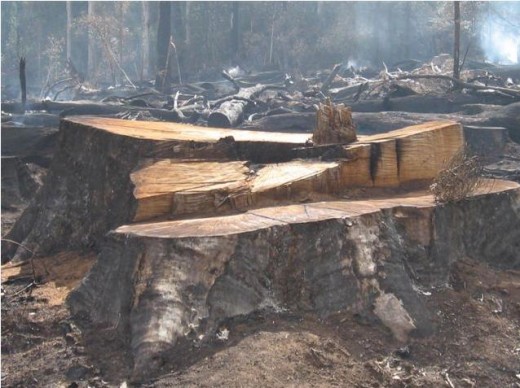 Vicforests’ logging arson to 600 year old Eucalyptus regnans in East Gippsland, Victoria, Australia, 20090423
http://www.lighterfootprints.org/2009/04/brown-mountain-destruction-complete.html Vicforests’ logging arson to 600 year old Eucalyptus regnans in East Gippsland, Victoria, Australia, 20090423
http://www.lighterfootprints.org/2009/04/brown-mountain-destruction-complete.html
This photo just in from the old growth forests of Brown Mountain in East Gippsland – home of remnant giant Australian natives dating up to 600 years old. This photo shows the Brown Mountain Massacre yesterday (23 April 2009) of these magnificent giants by VicForests on its celebrated World Forestry Day.
In 2006, the then Premier, Steve Bracks, made a promise to “protect all significant stands of old growth currently available for logging” (hollow words by a man of renouned indecision). The immense trees that have sheltered and raised hundreds of generations of owls and gliding possums are now being hacked down by VicForests.” [Source: Environment East Gippsland’s, ‘The Potoroo Review‘, Issue 196]
VicForests’ leadership inspiration, Warren Hodgson, must feel pround leaving such a legacy of heritage denial to future Gippslanders, Victorian and Australians. “Warren Hodgson has been involved in policy development at the highest level of the Victorian public sector and has previously led the Victorian Government efforts on Public Private Partnerships. He has a background in the manufacturing industry in New Zealand and in the provision of contract services to public and private sectors throughout the Asia-Pacific region.”
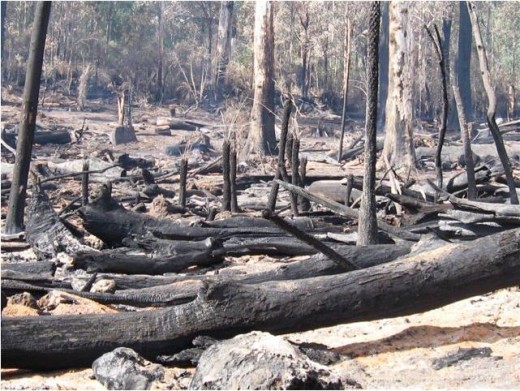
.
.
.
‘VicForests’ (from its website) presents its vision and values as:
.
Our vision:
“To be a leader in a sustainable Victorian timber industry.”
Our purpose:
“To build a responsible business that generates the best community value from the commercial management of Victoria’s State forests.”
Our values:
“Accountable – VicForests is accountable to the Victorian Government. Its actions and those of its employees must be consistent with relevant Government policy and priorities.”
Committed – “VicForests is committed to the fulfilment of its purpose and the achievement of its vision for the Victorian timber industry.”
Safe – “VicForests and its staff will manage safe workplaces for all staff and contractors, and are committed to continuous improvement in safety systems and outcomes, in accordance with its Occupational Health and Safety Policy.”
Customer focused – “VicForests will be responsive to its customers’ requirements and seek customer satisfaction, in accordance with its commercial nature.”
Ethical – “VicForests will operate in an ethical and environmentally responsible manner in all its undertakings to ensure the integrity and sustainability of the native forest timber industry in Victoria.”
Innovative – “VicForests seeks to be innovative and adaptable in its organisational, business and forestry management operations.”
Open – “VicForests will manage the commercial harvesting and sale of timber in a framework of openness and transparency.”
Professional – “VicForests and its staff will operate in a professional manner in all undertakings to ensure the best possible outcomes for the organisation, its customers, the Victorian timber industry and its stakeholders.”
Sustainable – “VicForests will pursue the highest standards for forest management practices through the continued development of its Sustainable Forest Management System and by ensuring its triple bottom line performance against the requirements of Victoria’s Sustainability Charter for State forests.”
[SOURCE: http://www.vicforests.com.au/vision-purpose-and-values.htm]
.
.
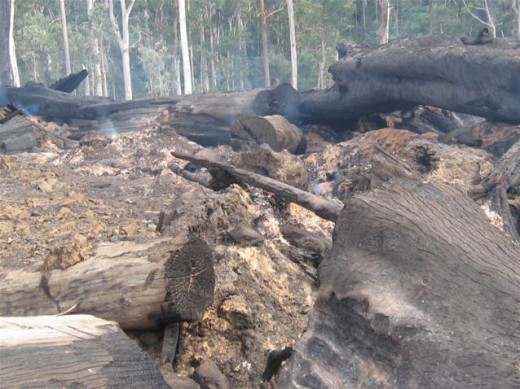
I have to pinch myself to realise this is 2009 and not 1959!
.
.
.
Brown Mountain – destruction complete!
.
An urgent message from Jill Redwood of Environment East Gippsland (from 20090424). . .
“These were taken yesterday – VicForests mission accomplished.
This ancient stand of 600(plus) year old forest has now been fully annihilated and ready for conversion to a palm-oil plantation. Or it might as well be.
They’ll actually be converted to a pulpwood plantation for the Japanese paper industry.
The other four remaining stands of old growth adjoining are on the logging schedule.
Please help in whatever way you can.”
~ Jill [Environment East Gippsland]
.
.
.
Read More:
.
[1] ^http://www.greenlivingpedia.org/Brown_Mountain_old_growth_forest
[2] ^http://www.eastgippsland.net.au/
[3] ^http://www.eastgippsland.net.au/?q=campaigns/brown_mountain
.
– end of article –
Thursday, July 28th, 2011
The following article was initially posted 20090414 by Tigerquoll on CanDoBetter.net:.

The UN position in 1992 on conserving native forests of the world:
.
‘At the 1992 United Nations Conference on Environment and Development (UNCED) the forest issue was among the most controversial, polarizing developing and developed countries.
In Rio de Janeiro, Brazil, intense negotiations among governments at UNCED resulted in the Non-legally Binding Authoritative Statement of Principles for a Global Consensus on the Management, Conservation and Sustainable Development of all Types of Forests, also known as the “Forest Principles”, as well as Chapter 11 of Agenda 21: Combating Deforestation.”
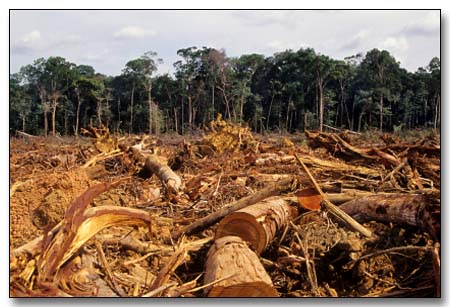
.
..
1992 Report of the United Nations Conference on Environment and Development [UNCED]
(Rio de Janeiro, 3-14 June 1992)
Extract from ‘Annex III’:
[NON-LEGALLY BINDING AUTHORITATIVE STATEMENT OF PRINCIPLES FOR A GLOBAL CONSENSUS ON THE MANAGEMENT, CONSERVATION AND SUSTAINABLE DEVELOPMENT OF ALL TYPES OF FORESTS]
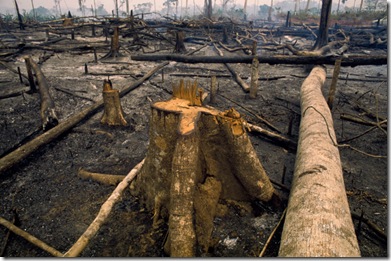
.
PREAMBLE
(a) The subject of forests is related to the entire range of environmental and development issues and opportunities, including the right to socio-economic development on a sustainable basis.
(b) The guiding objective of these principles is to contribute to the management, conservation and sustainable development of forests and to provide or their multiple and complementary functions and uses.
(c) Forestry issues and opportunities should be examined in a holistic and balanced manner within the overall context of environment and development, taking into consideration the multiple functions and uses of forests, including traditional uses, and the likely economic and social stress when these uses are constrained or restricted, as well as the potential for development that sustainable forest management can offer.
(d) These principles reflect a first global consensus on forests. In committing themselves to the prompt implementation of these principles, countries also decide to keep them under assessment for their adequacy with regard to further international cooperation on forest issues.
(e) These principles should apply to all types of forests, both natural and planted, in all geographical regions and climatic zones, including austral, boreal, subtemperate, temperate, subtropical and tropical.
(f) All types of forests embody complex and unique ecological processes which are the basis for their present and potential capacity to provide resources to satisfy human needs as well as environmental values, and as such their sound management and conservation is of concern to the Governments of the countries to which they belong and are of value to local communities and to the environment as a whole.
(g) Forests are essential to economic development and the maintenance of all forms of life.
(h) Recognizing that the responsibility for forest management, conservation and sustainable development is in many States allocated among federal/national, state/provincial and local levels of government, each State, in accordance with its constitution and/or national legislation, should pursue these principles at the appropriate level of government.
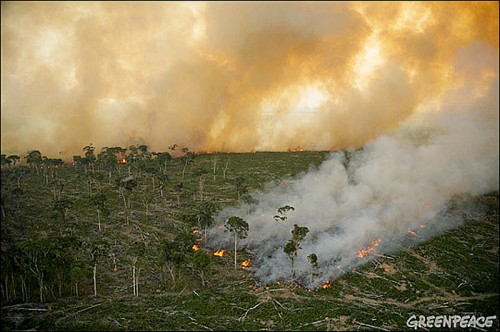
.
PRINCIPLES/ELEMENTS
.
1. (a) States have, in accordance with the Charter of the United Nations and the principles of international law, the sovereign right to exploit their own resources pursuant to their own environmental policies and have the responsibility to ensure that activities within their jurisdiction or control do not cause damage to the environment of other States or of areas beyond the limits of national jurisdiction.
(b) The agreed full incremental cost of achieving benefits associated with forest conservation and sustainable development requires increased international cooperation and should be equitably shared by the international community.
2. (a) States have the sovereign and inalienable right to utilize, manage and develop their forests in accordance with their development needs and level of socio-economic development and on the basis of national policies consistent with sustainable development and legislation, including the conversion of such areas for other uses within the overall socio-economic development plan and based on rational land-use policies.
(b) Forest resources and forest lands should be sustainably managed to meet the social, economic, ecological, cultural and spiritual needs of present and future generations. These needs are for forest products and services, such as wood and wood products, water, food, fodder, medicine, fuel, shelter, employment, recreation, habitats for wildlife, landscape diversity, carbon sinks and reservoirs, and for other forest products. Appropriate measures should be taken to protect forests against harmful effects of pollution, including air-borne pollution, fires, pests and diseases, in order to maintain their full multiple value.
(c) The provision of timely, reliable and accurate information on forests and forest ecosystems is essential for public understanding and informed decision-making and should be ensured.
(d) Governments should promote and provide opportunities for the participation of interested parties, including local communities and indigenous people, industries, labour, non-governmental organizations and individuals, forest dwellers and women, in the development, implementation and planning of national forest policies.
3. (a) National policies and strategies should provide a framework for increased efforts, including the development and strengthening of institutions and programmes for the management, conservation and sustainable development of forests and forest lands.
(b) International institutional arrangements, building on those organizations and mechanisms already in existence, as appropriate, should facilitate international cooperation in the field of forests.
(c) All aspects of environmental protection and social and economic development as they relate to forests and forest lands should be integrated and comprehensive.
4. The vital role of all types of forests in maintaining the ecological processes and balance at the local, national, regional and global levels through, inter alia, their role in protecting fragile ecosystems, watersheds and freshwater resources and as rich storehouses of biodiversity and biological resources and sources of genetic material for biotechnology products, as well as photosynthesis, should be recognized.
5. (a) National forest policies should recognize and duly support the identity, culture and the rights of indigenous people, their communities and other communities and forest dwellers. Appropriate conditions should be promoted for these groups to enable them to have an economic stake in forest use, perform economic activities, and achieve and maintain cultural identity and social organization, as well as adequate levels of livelihood and well-being, through, inter alia, those land tenure arrangements which serve as incentives for the sustainable management of forests.
(b) The full participation of women in all aspects of the management, conservation and sustainable development of forests should be actively promoted.
6. (a) All types of forests play an important role in meeting energy requirements through the provision of a renewable source of bio-energy, particularly in developing countries, and the demands for fuelwood for household and industrial needs should be met through sustainable forest management, afforestation and reforestation. To this end, the potential contribution of plantations of both indigenous and introduced species for the provision of both fuel and industrial wood should be recognized.
(b) National policies and programmes should take into account the relationship, where it exists, between the conservation, management and sustainable development of forests and all aspects related to the production, consumption, recycling and/or final disposal of forest products.
(c) Decisions taken on the management, conservation and sustainable development of forest resources should benefit, to the extent practicable, from a comprehensive assessment of economic and non-economic values of forest goods and services and of the environmental costs and benefits. The development and improvement of methodologies for such evaluations should be promoted.
(d) The role of planted forests and permanent agricultural crops as sustainable and environmentally sound sources of renewable energy and industrial raw material should be recognized, enhanced and promoted. Their contribution to the maintenance of ecological processes, to offsetting pressure on primary/old-growth forest and to providing regional employment and development with the adequate involvement of local inhabitants should be recognized and enhanced.
(e) Natural forests also constitute a source of goods and services, and their conservation, sustainable management and use should be promoted.
7. (a) Efforts should be made to promote a supportive international economic climate conducive to sustained and environmentally sound development of forests in all countries, which include, inter alia, the promotion of sustainable patterns of production and consumption, the eradication of poverty and the promotion of food security.
(b) Specific financial resources should be provided to developing countries with significant forest areas which establish programmes for the conservation of forests including protected natural forest areas. These resources should be directed notably to economic sectors which would stimulate economic and social substitution activities.
8. (a) Efforts should be undertaken towards the greening of the world.
All countries, notably developed countries, should take positive and transparent action towards reforestation, afforestation and forest conservation, as appropriate.
(b) Efforts to maintain and increase forest cover and forest productivity should be undertaken in ecologically, economically and socially sound ways through the rehabilitation, reforestation and re-establishment of trees and forests on unproductive, degraded and deforested lands, as well as through the management of existing forest resources.
(c) The implementation of national policies and programmes aimed at forest management, conservation and sustainable development, particularly in developing countries, should be supported by international financial and technical cooperation, including through the private sector, where appropriate.
(d) Sustainable forest management and use should be carried out in accordance with national development policies and priorities and on the basis of environmentally sound national guidelines. In the formulation of such guidelines, account should be taken, as appropriate and if applicable, of relevant internationally agreed methodologies and criteria.
(e) Forest management should be integrated with management of adjacent areas so as to maintain ecological balance and sustainable productivity.
(f) National policies and/or legislation aimed at management, conservation and sustainable development of forests should include the protection of ecologically viable representative or unique examples of forests, including primary/old-growth forests, cultural, spiritual, historical, religious and other unique and valued forests of national importance.
(g) Access to biological resources, including genetic material, shall be with due regard to the sovereign rights of the countries where the forests are located and to the sharing on mutually agreed terms of technology and profits from biotechnology products that are derived from these resources.
(h) National policies should ensure that environmental impact assessments should be carried out where actions are likely to have significant adverse impacts on important forest resources, and where such actions are subject to a decision of a competent national authority.
9. (a) The efforts of developing countries to strengthen the management, conservation and sustainable development of their forest resources should be supported by the international community, taking into account the importance of redressing external indebtedness, particularly where aggravated by the net transfer of resources to developed countries, as well as the problem of achieving at least the replacement value of forests through improved market access for forest products, especially processed products. In this respect, special attention should also be given to the countries undergoing the process of transition to market economies.
(b) The problems that hinder efforts to attain the conservation and sustainable use of forest resources and that stem from the lack of alternative options available to local communities, in particular the urban poor and poor rural populations who are economically and socially dependent on forests and forest resources, should be addressed by Governments and the international community.
(c) National policy formulation with respect to all types of forests should take account of the pressures and demands imposed on forest ecosystems and resources from influencing factors outside the forest sector, and intersectoral means of dealing with these pressures and demands should be sought.
10. New and additional financial resources should be provided to developing countries to enable them to sustainably manage, conserve and develop their forest resources, including through afforestation, reforestation and combating deforestation and forest and land degradation.
11. In order to enable, in particular, developing countries to enhance their endogenous capacity and to better manage, conserve and develop their forest resources, the access to and transfer of environmentally sound technologies and corresponding know-how on favourable terms, including on concessional and preferential terms, as mutually agreed, in accordance with the relevant provisions of Agenda 21, should be promoted, facilitated and financed, as appropriate.
12. (a) Scientific research, forest inventories and assessments carried out by national institutions which take into account, where relevant, biological, physical, social and economic variables, as well as technological development and its application in the field of sustainable forest management, conservation and development, should be strengthened through effective modalities, including international cooperation. In this context, attention should also be given to research and development of sustainably harvested non-wood products.
(b) National and, where appropriate, regional and international institutional capabilities in education, training, science, technology, economics, anthropology and social aspects of forests and forest management are essential to the conservation and sustainable development of forests and should be strengthened.
(c) International exchange of information on the results of forest and forest management research and development should be enhanced and broadened, as appropriate, making full use of education and training institutions, including those in the private sector.
(d) Appropriate indigenous capacity and local knowledge regarding the conservation and sustainable development of forests should, through institutional and financial support and in collaboration with the people in the local communities concerned, be recognized, respected, recorded, developed and, as appropriate, introduced in the implementation of programmes. Benefits arising from the utilization of indigenous knowledge should therefore be equitably shared with such people.
13. (a) Trade in forest products should be based on non-discriminatory and multilaterally agreed rules and procedures consistent with international trade law and practices. In this context, open and free international trade in forest products should be facilitated.
(b) Reduction or removal of tariff barriers and impediments to the provision of better market access and better prices for higher value-added forest products and their local processing should be encouraged to enable producer countries to better conserve and manage their renewable forest resources.
(c) Incorporation of environmental costs and benefits into market forces and mechanisms, in order to achieve forest conservation and sustainable development, should be encouraged both domestically and internationally.
(d) Forest conservation and sustainable development policies should be integrated with economic, trade and other relevant policies.
(e) Fiscal, trade, industrial, transportation and other policies and practices that may lead to forest degradation should be avoided. Adequate policies, aimed at management, conservation and sustainable development of forests, including, where appropriate, incentives, should be encouraged.
14. Unilateral measures, incompatible with international obligations or agreements, to restrict and/or ban international trade in timber or other forest products should be removed or avoided, in order to attain long-term sustainable forest management.
15. Pollutants, particularly air-borne pollutants, including those responsible for acidic deposition, that are harmful to the health of forest ecosystems at the local, national, regional and global levels should be controlled.’
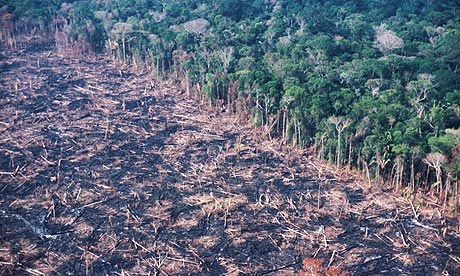
.
.
The UN position in 2007:
.
‘Following nearly 3 years of intense negotiations, starting from UNFF5 and culminating at UNFF7, the Non-Legally Binding Instrument on All types of Forests was adopted on 28 April 2007. The Instrument was adopted by the UN General Assembly (Resolution 62/98) on 17 December 2007.
The purpose of this instrument is:
(a) To strengthen political commitment and action at all levels to implement effectively sustainable management of all types of forests and to achieve the shared global objectives on forests;
(b) To enhance the contribution of forests to the achievement of the internationally agreed development goals, including the Millennium Development Goals, in particular with respect to poverty eradication and environmental sustainability;
(c) To provide a framework for national action and international cooperation.’
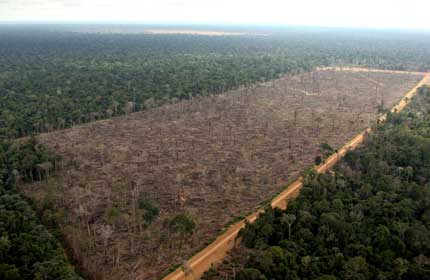
– end of article –
.
.
Rainforest Reality, 2011:
.
‘Deforestation in Brazil’s Amazon Region Increases 400% in One Year’ [ May 2011]
[20110520, hispanicallyspeakingnews.com]
.
‘Brazil is reporting a dramatic increase in deforestation in the Amazon that has the country’s environmental protectionists and some government officials troubled. In just one year – March/April of 2010 -2011 – Brazil’s Amazon has seen a 400 percent increase in the amount of acres that have undergone deforestation – 25,451 acres to 146,533, according to satellite images from the Brazilian space research institute.
Environmental protectionists believe the increased demand for cattle and soy are behind the decision to clear so many acres, while other blame the government for not being hesitant in regards to laws to regulate deforestation. The country’s Environmental Minister Izabella Teixeira said she was troubled to see the satellite images, and said the government would establishing a special panel to address the matter.
Currently, Brazilian law states that 80 percent of the land in the Amazon region must remain forested, and that has been in place since 1934. Still, deforestation advocates claim additional clearing is needed. In the state of Mato Grosso, deforestation occurs in large part to make room for soybean production.’
.
[Source: ^ http://www.hispanicallyspeakingnews.com/notitas-de-noticias/details/deforestation-in-brazils-amazon-region-increases-400-in-one-year/7782/, accessed 20110728]
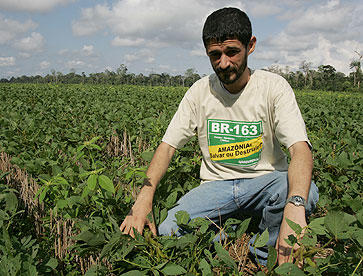
Editor’s comment: ‘This the consequence of ‘non-legally binding UN ‘Forest Principles’.’
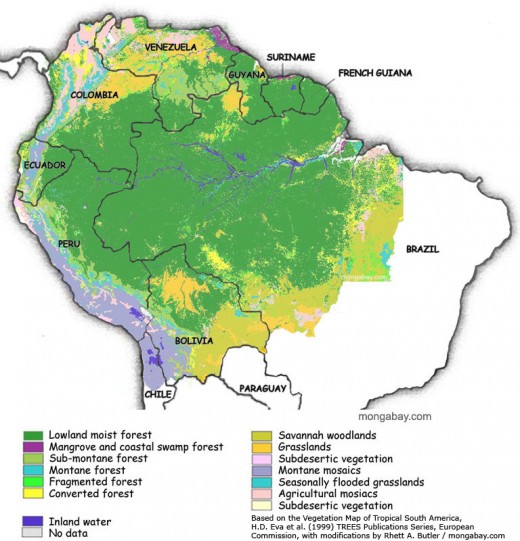
.
.
Read More:
.
[1] United Nations Forum on Forests, ^http://www.un.org/esa/forests/
[2] Mongabay.com, ^http://www.mongabay.com/brazil.html
[3] Greenpeace.org, ^http://www.greenpeace.org/international/en/press/releases/second-largest-rate-of-amazon/
[4] Greenpeace campaign to save the Amazon, ^http://www.greenpeace.org/international/en/campaigns/forests/amazon/
[5] ‘Deforestation in decline but rate remains alarming, UN agency says‘, UN News Centre, ^http://www.un.org/apps/news/story.asp?NewsID=34195
[6] ‘REDD’, The United Nations Collaborative Programme on Reducing Emissions from Deforestation and Forest Degradation in Developing Countries, ^http://www.un-redd.org/
[7] ‘UN: $40bn a year could halve deforestation worldwide‘, by Will Nichols, 20110606, Business Green, ^http://www.businessgreen.com/bg/news/2076417/-usd40bn-halve-deforestation-worldwide
.
(above references accessed 20110728)
.
– end of article –
Tags: Agenda 21: Combating Deforestation, Amazon forest, deforestation, Forest Principles, old growth conservation, old growth forest, Rainforest Reality, soybean, tigerquoll, U.N. Principles, UNCED, UNFF
Posted in Amazon (BR), Threats from Deforestation, Threats from Farming | No Comments »
Add this post to Del.icio.us - Digg
Wednesday, July 20th, 2011
The following article was initially posted by Tigerquoll on 20090326 on CanDoBetter.net:
.
On Thursday 26th March 2009, four people were charged in their efforts to save East Gippsland old growth forests at Upper Delegate River from being chopped down.
 ‘The Goongerah Blockade’ ‘The Goongerah Blockade’
Protesting against logging of old growth forests in East Gippsland
….prepared to be arrested for habitat.
March 2009.
eco-warriors all!
.
Conservationists trying to conserve protected old growth forests have been charged with illegal conservation. Is Victorian Premier Brumby’s strongman stance seeking to emulate Mugabean democracy?
Is Brumby’s hypocritical law for conservationists that of prima facie guilt of conservation? Surely the need to conserve rare and remnant old growth forests makes conservation self-evident?
Premier Brumby’s DSE and VicForests under their own laws maintain these catchment forests under environmental protection legislation. Yet in breach of their own laws, Brumby’s environmental watchdogs have become lapdogs, watching loggers irreparably destroy these centuries-old Eucalypts and lay witness to Victoria’s disappearing natural heritage. It’s no different to Indonesia condoning destruction of Sumatran and Kalimantan rainforests.
When was the last time Brumby bushwalked through old growth Gippsland? Last year, or never?
A dedicated group of 20 forest conservationists prevented clearfelling in the upper Delegate River catchment up until now. “This particular old growth forest was recently surveyed by trained biologists and the result showed very high density of tree dwelling mammals”, said spokesperson for the group Carmel Roberts.
“The DSE is neglecting their responsibilities to protect endangered wildlife habitat, even though it clearly states in their Forest Management Plan that where high numbers of threatened species are found, habitat must be protected.
“The DSE are saying they are unable to protect these species’ habitat despite the logging being in clear breach of their legal obligations. The government puts more value on a months work by a few people than protecting endangered wildlife from extinction.
“In 2006, Premier Brumby made an election promise to protect the “last significant stands of old growth”. These forests are the very the last refuges for our rare species.”
“Since the devastation caused by the bushfires, East Gippsland’s forests are now even more critical to the survival of Victoria’s native species than before. Rare native wildlife could have been made locally extinct in other areas due to the fire damage.”
“Old growth forest habitats such as hollow-bearing trees, are critically important for the survival of these threatened species in Victoria. The logging industry can survive in plantations and regrowth, endangered wildlife can’t.”
.
.
Comments:
.
Woodchip mafia has Brumby well trained
March 28th, 2009 by ‘Blackdog’:
.
The Brumby government is truly the lapdog to the loggers. The woodchip mafia has him well trained. The rule book says the threatened species have to be saved. He destroys them and their habitat. The promise back in 2006 was to save the old growth – but all he’s done is cover for the increased targeting of prime areas.
Yep – no different to Indonesia or the Amazon. Only Brumby employs better media spin experts. Pity the public don’t wear it.
.
.
Lap dog governments are following Easter Island
On March 28th, 2009 Tigerquoll says:
Blackdog’s comments hit the mark.
I go further than black dog.
Lap dog governments are supporting destructionist loggers while publicly advocating environmental protection in another department.
This is gross hypocracy, a conflict of interest and corrupt.
I worry also that as more clever HSC graduates take on degrees in ‘communications’, which so frequently entices them into well paid jobs in government and corporate spin machines, that pure ethics is neglected at both senior school and at most university courses.
By denying our children skills and wisdom in worldly ethics, our children are being denied their rights to cope with ethical decisions. A degree without a base in ethics is a degree in propaganda, and don’t our lapdog governments lap them up?
Take the following example and ask why in our education system and supposed independent journalism, that Australians are more aware of the extremely rich celebrities than the natural and indigenous exploitation and neglect condoned by governmenst in Australia’s World region?
SOURCE: www.drmartinwilliams.com/conservation-and-environment/indonesian-forest-destruction-corruption-plays-a-role.html
“Since 1982, forest fires on a large scale in Kalimantan, Sumatra and Java have come with the onset of each dry season. A fire in Kalimantan in 1983, reportedly the largest in human history, destroyed 3.7 million hectares of rainforest, an area the size of the Netherlands.
In 1987, 2 million hectares, 1.4 million of primary rainforest, were destroyed in Kalimantan, Sumatra, East Timor, Sulawesi and mountain regions of Java.
In 1991 smoke and ash from fires blanketed Singapore, Malaysia and the Straits of Malacca, forcing Indonesia to call for international help.
Forest fires of this magnitude coincide with a rapid increase in logging and plantation activities which began in the early 1980s. In 1966, 82% of Indonesia’s land mass was covered by primary forest. By 1982 this had shrunk to 68%, and recent satellite photographs indicate that forest cover – including timber plantations – is now down to about 55%.
In late 1996, the Indonesian minister of forests said that 20 million hectares of forest were in a critical state and warned that this was increasing rapidly. The World Bank estimates 800,000 hectares of forest are lost each year.
Around 64 million hectares – one-third of Indonesia’s land mass – is devoted to commercial logging. In 1996 Indonesia became the world’s largest plywood exporter.
…
On September 9, Suharto reissued a 1995 ban on burning forest and called on the military to help enforce it. Companies were given until October 3 to prove they were not the culprits.
Laws allow up to 10 years’ imprisonment and a 100 million rupiah fine for polluters. Not one company, however, has ever been convicted. Even the environment minister, Sarwono Kusumaatmadja, admitted to Reuters on September 22 that environmental laws are not policed properly.
Soon after Suharto’s announcement, the number of fires increased, as companies rushed to clear as much land as possible before the deadline. Even if the deadline was strictly adhered to, it would only let companies finish clearing land at a time the normal rainy season would have forced them to do so.
…
But it is not just the greed of Suharto and the logging and plantation firms which has created this disaster.
Government investment and development policies which have promoted destructive land clearing practices are spurred on by market forces and capitalism’s endless drive for profit. Many of the projects were championed by and funded by institutions such as the World Bank and the IMF, which pressure countries such as Indonesia to increase exports.”
In 2009, we must learn from Easter Island’s ancient community and its unsustainable culture of nature exploitation which ended up condemning its civilization to extinction. Else, despite our iPods, in 2009 we risk the same fate.
.
.
Injustice rules the forests
March 30th, 2009 by Sheila Newman:
.
About time this shameful situation got coverage. I would like to see a story for EVERY charge against conservationists on candobetter.
It is quite true, as you say, that the Victorian Government frequently breaks the law in its forest activities. In fact it has practically torn up its own rule book.
Keep fighting!
.
– end of article –
Tags: Carmel Roberts, clear felling, conservationists charged, East Gippsland, Goongerah Blockade, John Brumby, Logging, old growth forests, Premier Brumby, tigerquoll, Upper Delegate River, VicForests, woodchip
Posted in Gippsland (AU), Threats from Deforestation | No Comments »
Add this post to Del.icio.us - Digg
|
|
 Aerial Arson of Mt Cronje
(A recent example of aerial arson to the Blue Mountains World Heritage)
Aerial Arson of Mt Cronje
(A recent example of aerial arson to the Blue Mountains World Heritage)
 Aerial incendiary dropped from helicopter in National Park wilderness
Aerial incendiary dropped from helicopter in National Park wilderness
 $62.5 million is going to setting fire to Blue Mountains World Heritage
How much or little goes to protecting endangered wildlife and their Recovery Plans?
Zilch across the Blue Mountains?
$62.5 million is going to setting fire to Blue Mountains World Heritage
How much or little goes to protecting endangered wildlife and their Recovery Plans?
Zilch across the Blue Mountains?

































